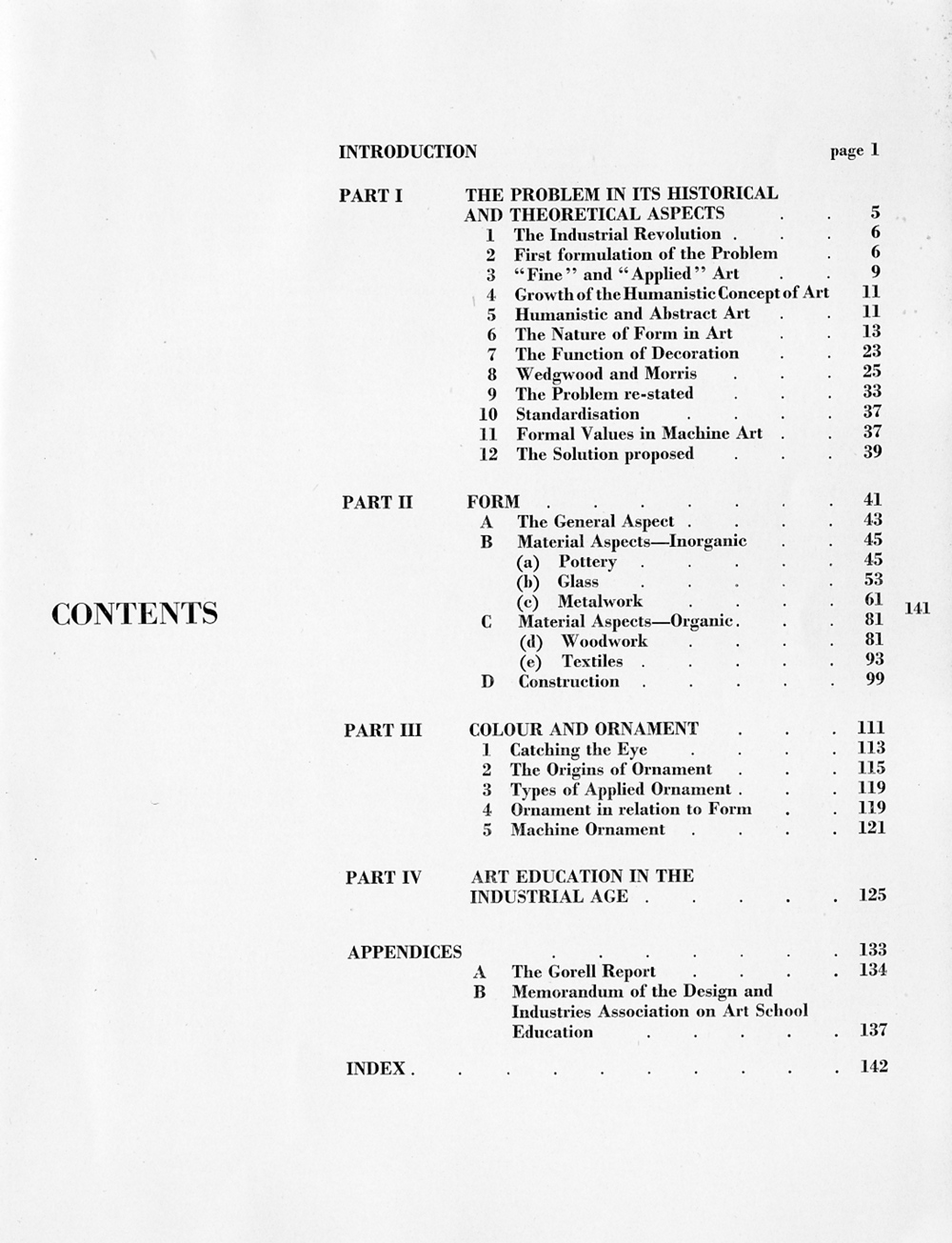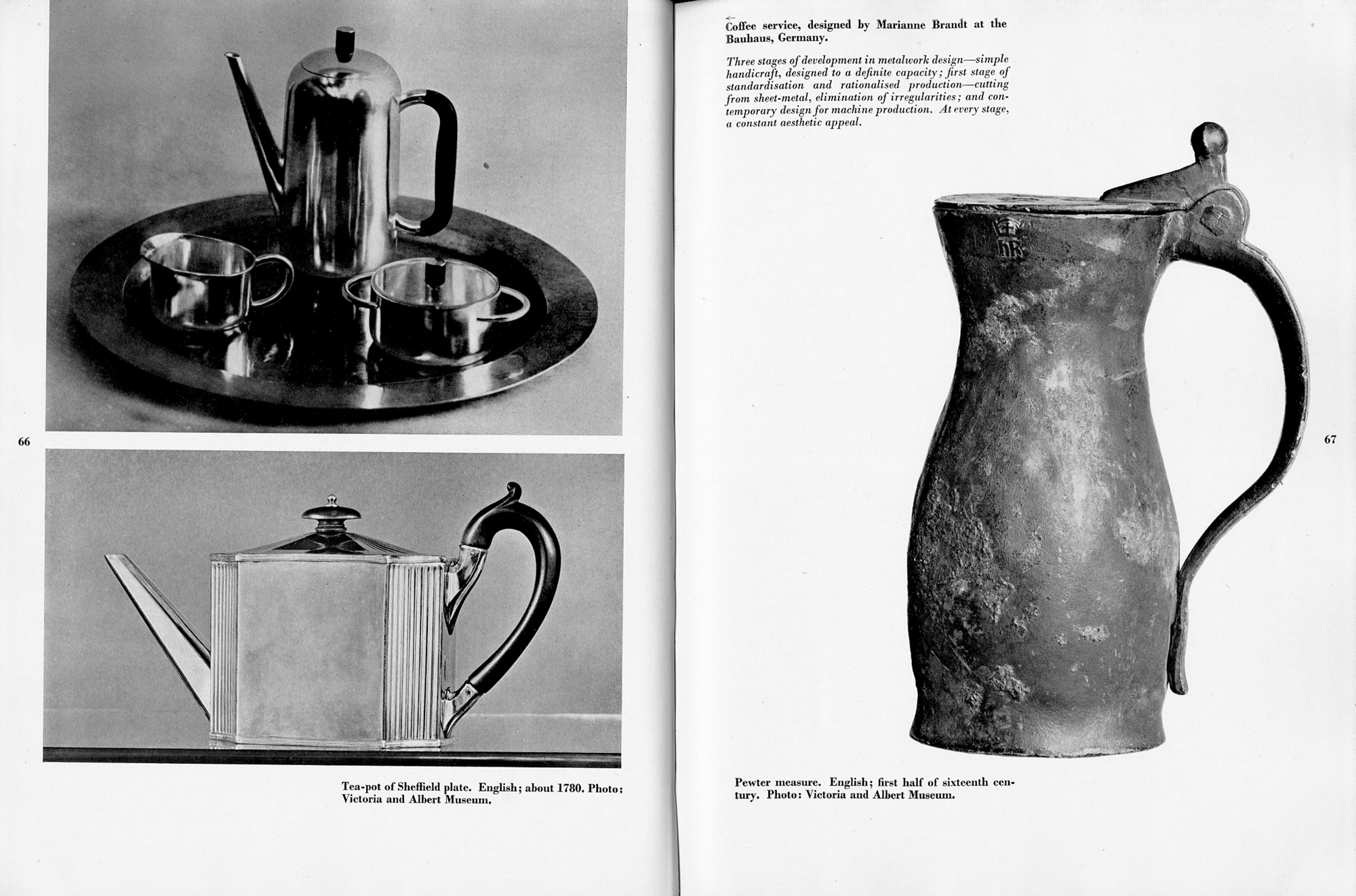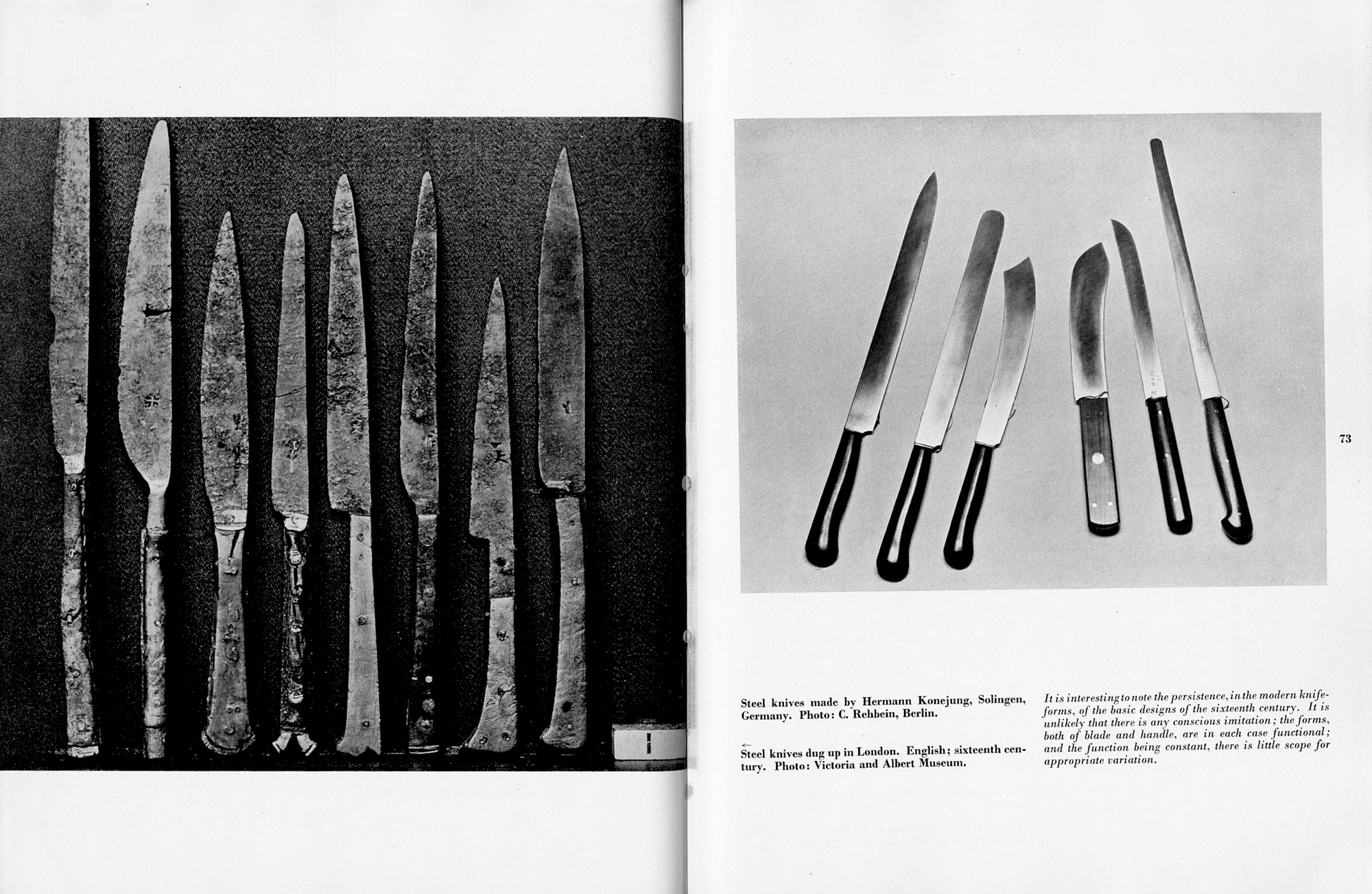|
|
Read H. Art and Industry: The Principles of Industrial Design. — New York, 1935  Art and Industry: The Principles of Industrial Design / Herbert Read. — New York : Harcourt, Brace and Company, 1935. — 143 p., ill.
One of the most important texts promoting Modernism published in Britain. The layout was designed by former Bauhaus tutor Herbert Bayer. “In this text, the designer is portrayed as an abstract artist working in industry, reconciling elements of design such as materials, form, colour, and proportion with modern mass-production technology. Read felt that the designer should play a central role in modern manufacture, rather than the low-paid, subservient role that generally prevailed at the time.”
INTRODUCTION
The aim of this book may be stated quite briefly. For more than a hundred years an attempt has been made to impose on the products of machinery aesthetic values which are not only irrelevant, but generally costly and harmful to efficiency. Those aesthetic values were associated with the previously prevailing handicraft methods of production, but they were not essential even to these. Actually they were the superficial styles and mannerisms of the Renaissance tradition of ornament. Nevertheless, the products of machinery were at first judged by the standards of this tradition, and though there have been attempts, notably the one led by Ruskin and Morris, to return to the more fundamental aspects of handicraft—that is to say, to the forms underlying the ornament—yet the problem in its essentials remains unsolved. For the real problem is not to adapt machine production to the aesthetic standards of handicraft, but to think out new aesthetic standards for new methods of production.
In other words, what is required as a preliminary to any practical solution of the division existing between art and industry is a clear understanding, not only of the processes of modern production, but also of the nature of art. Not until we have reduced the work of art to its essentials, stripped it of all the irrelevancies imposed on it by a particular culture or civilisation, can we see any solution of the problem. The first step, therefore, is to define art; the second is to estimate the capacity of the machine to produce works of art.
The work of art is shown to be essentially formal; it is the shaping of material into forms which have a sensuous or intellectual appeal to the average human being. To define the nature and operation of this appeal is not an easy task, but it must he faced by anyone who wishes to see a permanent solution of the problem that concerns us.
The problem, that is to say, is in the first place a logical or dialectical one. It is the definition of the normal or universal elements in art.
It is then complicated by the purposes which the objects we are shaping have to serve. That is to say, we are concerned, not with works of art whose only purpose is to please the senses or intellect, but with works of art that must perform in addition a utilitarian function.
One false theory assumes that if the object in question performs its function in the most efficient way possible, it will ipso facto possess the necessary aesthetic qualities. To this argument we must reply that an object which functions perfectly may, and probably will, possess aesthetic qualities, but that the connection is not a necessary one. Aesthetic values are absolute or universal values to which an object, restricted by its function to a particular form, may approach; but by very reason of its particularity, cannot inevitably assume. In other words, art implies values more various than those determined by practical necessity.
The people concerned with the production of industrial objects are not normally interested in such metaphysical distinctions; but just as the sciences of physics and chemistry are necessary to the material and structural side of their productions, so the science of art is necessary to the formal side; and this problem of the relation of art to industry will never be solved unless industrialists are willing to consult the expert in the theory of art as willingly as they consult the expert in chemistry or physics. The study of art is an extremely exacting occupation, calling for a wide range of faculties and specialist knowledge, and for the most logical and disinterested thought. It is no exaggeration to say that years of discussion have been wasted, and many markets lost, simply because the difficulty of the subject has not been recognised, and the proper authorities have not been consulted.
In reality, the situation has been more desperate still, for the proper authorities have not existed. In English-speaking countries, at any rate, there has been, until recent years, no fundamentally serious study of the problems of art; and if men of the intelligence of Ruskin and Morris approached the subject with the grossest illusions and prejudices, it is hardly to be expected that practical men of affairs should solve the problem.
But actually it is the practical men of affairs who have solved the problem. It is the engineers who built the Forth Bridge and the Crystal Palace, who more recently evolved the form of the automobile and the aeroplane, who first unconsciously suggested the elements of a new aesthetic. Their suggestions were picked up by more conscious architects and designers, and gradually, in a few pioneer spirits, the old and inappropriate traditions were discarded, and a new tradition, based on practical realities, was evolved. This tradition still needs formulation, and in the pages that follow I have attempted to give the first sketch of such a formulation. But we are still in the stage of experiment and research—practical experiment and research—and it will be many years before these first principles can be given any full systematic exposition and illustration. At present one must generalise from analogies in the past, and on very slender and inadequate evidence of the present day.
The objection which I must meet in this Introduction relates to the validity of that evidence. If we reject the aesthetic faith of Sir Joshua Reynolds, Ruskin, Morris, the Royal Academy, the Royal College of Art, and 58,000 deluded art students, and turn to the work of a few practical engineers and technical designers, it will be said that work so unconscious of aesthetic purpose cannot for a moment be compared with craftsmanship based on the tradition of five centuries. It will be seen that in the first place I question the accepted interpretation of this tradition; that I distinguish sharply between the humanistic and formal elements in such art; and that then I would seem to reject the whole humanistic tradition, at least in so far as it concerns objects of use.
If I do so, it is because I am conscious that there is a subtle distinction between “humanistic” and “human”; and conscious, too, that beyond the so-called humanistic tradition, there is an older tradition which offers many analogies to the new tradition emerging today. In the twelfth and thirteenth centuries, as in the fifth century B.C., there existed, in Northern Europe and in Greece respectively, phases of architectural development, and of industrial design generally, that have never been excelled in history. There is one significant fact about such periods: they are without an aesthetic. What they did, they did as the solution of practical problems, without taste, without academic tradition. There is no medieval treatise on art; it is barely mentioned in the whole of the scholastic philosophy as a separate category, and when mentioned, is always regarded as a practical activity, whose aim is clarity, order, harmony and functional integrity. The position is similar in Ancient Greece, and not until Greek art is decadent does anything in the nature of a conscious aesthetic find expression. Today we are entering on such another phase in the history of art. Social and economic reorganisation, the introduction of new materials which revolutionise the structural principles of building, the development of transport and communications, all these and similar events have created innumerable practical problems; and the immediate need is the solution of these problems in the most efficient fashion. If the urgent problem is the transformation of a million slum dwellings into cities of order, light, health and convenience, the men who will be engaged on the practical problem of such a transformation will find questions of ornament and decoration singularly futile and academic—a waste of time and money. Their problem is not academic, but human and rational. They have to design houses which embody an ideal of decent living on a communal scale; to do this they will need imagination and science. Imagination and science—what more has any great work of art ever required? In the solution of the immediate practical problems of the day, all the necessary opportunities for a great tradition of design exist. If that tradition is not realised, it will be due to the imposition of false and irrelevant ideals of art.
These false ideals are for the most part fostered by our academies, institutes, and schools of art. I am almost forced to the conclusion, when I come to consider the problem of education in this book, that on the whole we should benefit from the total abolition of all academic instruction in art; that the only instruction that is necessary is technical instruction, out of which the practical questions of design automatically arise. But if academic education may with benefit be abolished, another form of education, education in appreciation, must be developed. The general principles of harmony and proportion, and the development of sensuous and intellectual perceptivity, must be taught on a new and extensive scale, especially at the elementary stage of education. That immense difficulties exist in devising such education must be admitted; a new pedagogic method is required. But I am convinced that the instincts for the appreciation of abstract form are widely diffused, and some evidence of this fact may be derived from one of those popular extensions of language which are so significant and so little observed. I refer to the very general use of the word “streamline”, and its derivatives. Its origin is, of course, technical and scientific; it is a term used in hydrodynamics for a fine drawn from point to point so that its direction is everywhere that of the motion of the fluid. From this severely scientific use, it was extended to denote the shape of a solid body designed so that it meets with the smallest amount of resistance in passing through the atmosphere—for example, a motor-car or aeroplane. But the use is now much more extensive, and “streamlined ” is popularly, if inaccurately, used as a term of approval for the design of any object of daily use. The point I wish to make is that by the use of such an expression the man-in-the-street is betraying his instinctive aesthetic judgments—aesthetic judgments which owe nothing to the standards of traditional taste and academic art—judgments which are, in fact, evidence of a new aesthetic sensibility. The same kind of sensibility permeated the societies that built the Parthenon and the cathedrals of the Middle Ages, and such a sensibility will eventually create comparable monuments of art for the societies of the future.
CONTENTS
INTRODUCTION 1
PART I
THE PROBLEM IN ITS HISTORICAL AND THEORETICAL ASPECTS 5
1 The Industrial Revolution ... 6
2 First formulation of the Problem 6
3 “Fine” and “Applied” Art . 9
4 Growth of the Humanistic Concept of Art 11
5 Humanistic and Abstract Art 11
6 The Nature of Form in Art 13
7 The Function of Decoration 23
8 Wedgwood and Morris .25
9 The Problem re-stated ... 33
10 Standardisation .37
11 Formal Values in Machine Art . 37
12 The Solution proposed ... 39
PART II
FORM.41
A The General Aspect . . . .43
B Material Aspects—Inorganic . 45
(a) Pottery .. 45
(b) Glass ...53
(c) Metalwork . . .61
C Material Aspects—Organic. . .81
(d) Woodwork . 81
(e) Textiles .. 93
D Construction .. 99
PART III
COLOUR AND ORNAMENT . .111
1 Catching the Eye . 113
2 The Origins of Ornament . . 115
3 Types of Applied Ornament . . .119
4 Ornament in relation to Form . 119
5 Machine Ornament . 121
PART IV
ART EDUCATION IN THE INDUSTRIAL AGE..125
APPENDICES 133
A The Gorell Report . 134
B Memorandum of the Design and Industries Association on Art School Education .. 137
INDEX.142
Sample pages
Download link (pdf, yandexdisk; 145 MB).
Все авторские права на данный материал сохраняются за правообладателем. Публикация электронной версии данной книги является рекламой бумажного издания и носит ознакомительный характер. Любое коммерческое использование запрещено. В случае возникновения вопросов в сфере авторских прав пишите по адресу 42@tehne.com.
12 июля 2015, 3:38
0 комментариев
|
Партнёры
|









